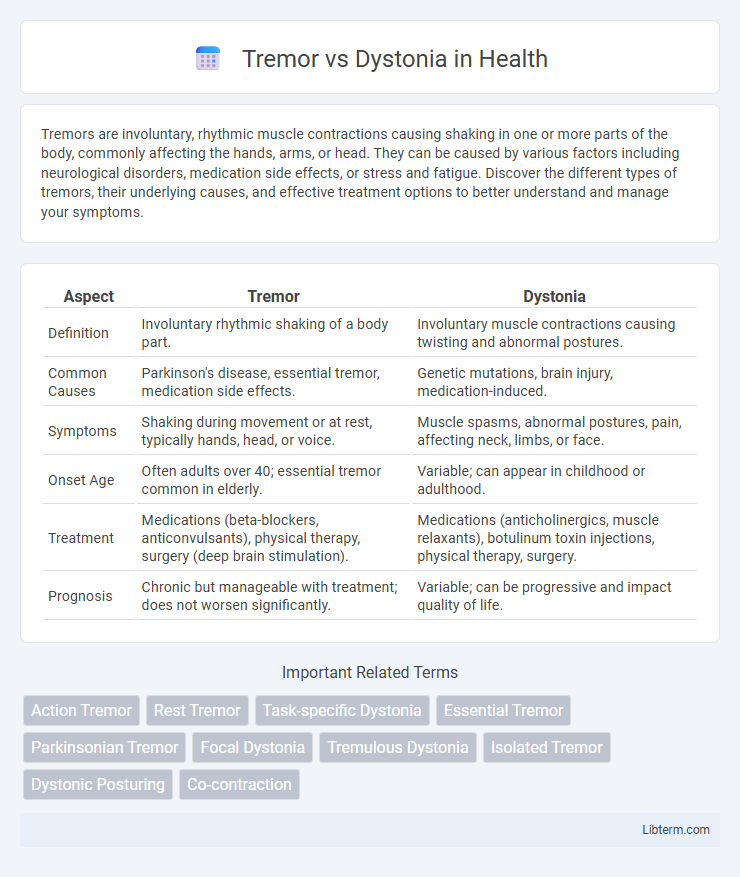Tremors are involuntary, rhythmic muscle contractions causing shaking in one or more parts of the body, commonly affecting the hands, arms, or head. They can be caused by various factors including neurological disorders, medication side effects, or stress and fatigue. Discover the different types of tremors, their underlying causes, and effective treatment options to better understand and manage your symptoms.
Table of Comparison
| Aspect | Tremor | Dystonia |
|---|---|---|
| Definition | Involuntary rhythmic shaking of a body part. | Involuntary muscle contractions causing twisting and abnormal postures. |
| Common Causes | Parkinson's disease, essential tremor, medication side effects. | Genetic mutations, brain injury, medication-induced. |
| Symptoms | Shaking during movement or at rest, typically hands, head, or voice. | Muscle spasms, abnormal postures, pain, affecting neck, limbs, or face. |
| Onset Age | Often adults over 40; essential tremor common in elderly. | Variable; can appear in childhood or adulthood. |
| Treatment | Medications (beta-blockers, anticonvulsants), physical therapy, surgery (deep brain stimulation). | Medications (anticholinergics, muscle relaxants), botulinum toxin injections, physical therapy, surgery. |
| Prognosis | Chronic but manageable with treatment; does not worsen significantly. | Variable; can be progressive and impact quality of life. |
Understanding Tremor and Dystonia
Tremor is an involuntary, rhythmic shaking movement often linked to neurological conditions such as Parkinson's disease or essential tremor, characterized by oscillatory muscle contractions. Dystonia involves sustained or intermittent muscle contractions causing abnormal, often repetitive movements or postures, frequently resulting from basal ganglia dysfunction. Differentiating tremor from dystonia requires assessing movement patterns, triggers, and affected muscle groups to enable accurate diagnosis and targeted treatment approaches.
Key Differences Between Tremor and Dystonia
Tremor is characterized by rhythmic, involuntary shaking movements, often affecting hands, head, or voice, while dystonia involves sustained or repetitive muscle contractions causing twisting or abnormal postures. Tremors typically worsen with movement or stress, whereas dystonic movements can be task-specific and may improve with sensory tricks or medications. Differentiating these conditions is crucial for targeted treatment since tremors often respond to beta-blockers or anticonvulsants, while dystonia may require botulinum toxin or deep brain stimulation.
Causes and Risk Factors
Tremor is primarily caused by neurological disorders such as Parkinson's disease, essential tremor, or drug-induced side effects, often influenced by genetic predisposition and age. Dystonia stems from abnormal brain signaling, particularly in the basal ganglia, with causes including genetic mutations, brain injuries, or exposure to certain medications, with risk factors encompassing family history and environmental triggers. Both movement disorders exhibit distinct etiologies, emphasizing the role of neurodegeneration, genetic background, and external factors in their development.
Signs and Symptoms
Tremor presents as rhythmic, involuntary shaking most commonly in the hands, head, or voice, often worsening during movement or stress. Dystonia involves sustained or intermittent muscle contractions causing abnormal postures or repetitive movements, frequently affecting the neck, eyelids, or limbs. While tremor is characterized by oscillatory motion, dystonia's hallmark is muscle stiffness and twisting, often accompanied by pain or discomfort.
Diagnosis: How Are Tremor and Dystonia Identified?
Tremor and dystonia are diagnosed through clinical evaluation involving detailed patient history and neurological examination, focusing on movement patterns, distribution, and triggers. Electromyography (EMG) and neuroimaging such as MRI can assist in distinguishing dystonia's sustained muscle contractions from the rhythmic shaking characteristic of tremors. Differential diagnosis may include assessment scales like the Fahn-Tolosa-Marin Tremor Rating Scale for tremors and Burke-Fahn-Marsden Dystonia Rating Scale for dystonia, aiding in precise identification and treatment planning.
Common Misconceptions
Tremor and dystonia are often confused due to their shared characteristic of involuntary muscle movements, but tremors are rhythmic shaking, while dystonia involves sustained or intermittent muscle contractions causing twisting or abnormal postures. A common misconception is that all tremors worsen with movement, yet essential tremor typically increases during action, whereas Parkinsonian tremor often occurs at rest. Many also wrongly assume dystonia is always painful, but although discomfort is common, the primary issue is abnormal muscle activity rather than pain itself.
Treatment Options for Tremor
Treatment options for tremor primarily include medications such as beta-blockers (propranolol) and anticonvulsants (primidone), which help reduce symptom severity. For patients with medication-resistant tremors, surgical interventions like deep brain stimulation (DBS) targeting the thalamus provide significant symptom relief. Physical and occupational therapy also support tremor management by improving motor control and daily function.
Treatment Strategies for Dystonia
Treatment strategies for dystonia primarily involve botulinum toxin injections, which effectively reduce muscle contractions and abnormal postures by blocking nerve signals. Oral medications such as anticholinergics, muscle relaxants, and benzodiazepines may complement therapy but often have limited efficacy and side effects. In refractory cases, deep brain stimulation (DBS) targeting the globus pallidus internus demonstrates significant motor improvement by modulating dysfunctional neural circuits.
Living with Tremor or Dystonia: Management Tips
Effective management of tremor and dystonia involves tailored medication regimens such as beta-blockers or anticholinergics, and botulinum toxin injections to reduce muscle contractions. Incorporating physical therapy and occupational therapy helps improve motor function and daily living skills, while stress management techniques like mindfulness can alleviate symptom severity. Utilizing assistive devices and seeking support from specialized neurologists enhances overall quality of life for individuals living with these movement disorders.
When to Seek Medical Advice
Seek medical advice for tremor when involuntary shaking interferes with daily activities such as writing, eating, or drinking, or if the tremor worsens progressively or occurs at rest. For dystonia, consult a healthcare professional if sustained muscle contractions cause abnormal postures, pain, or impaired movement that affects quality of life. Early diagnosis and treatment can prevent symptom progression and improve functional outcomes.
Tremor Infographic

 libterm.com
libterm.com